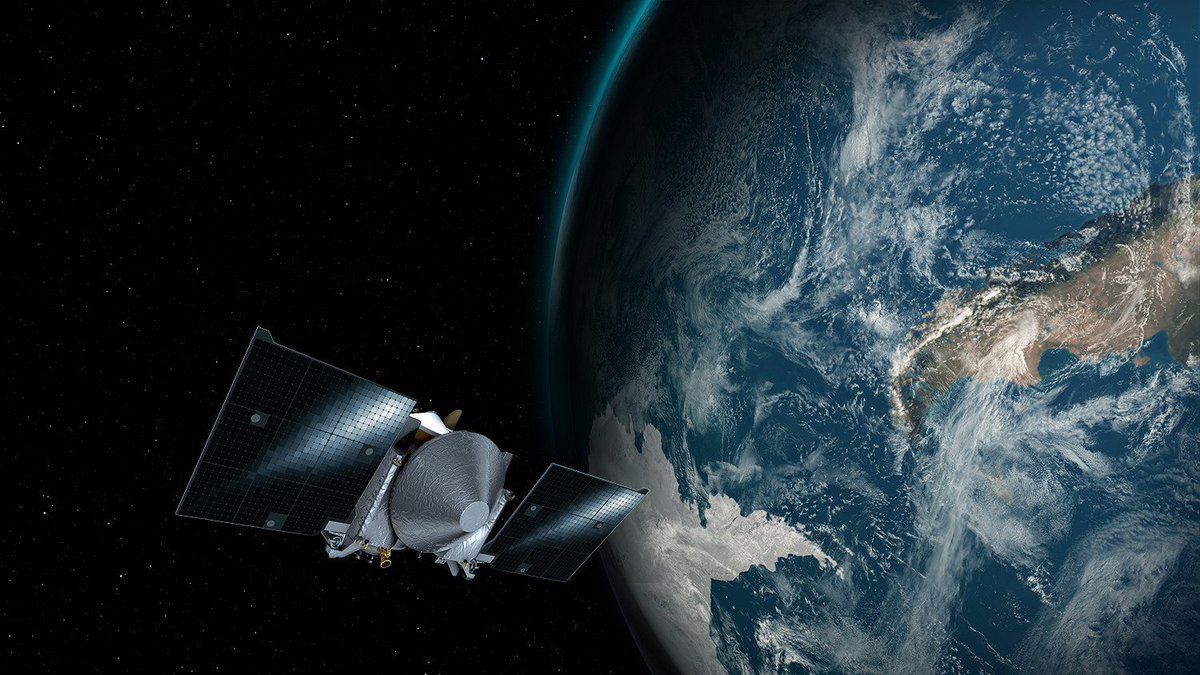
Artist's concept shows the OSIRIS-REx spacecraft passing by Earth on Sept. 22, 2017. Credits: NASA's Goddard Space Flight Center/University of Arizona
KENNEDY SPACE CENTER, FL - Barely a year after NASA's OSIRIS-REx robotic asteroid sampler launched on a trailblazing mission to snatch a soil sample from a pristine asteroid and return it to Earth for research analysis, the probe is speeding back home for a swift slingshot around our home planet on Friday Sept. 22 to gain a gravity assist speed boost required to complete its journey to the carbon rich asteroid Bennu and back.
As it swings by Earth NASA's first ever asteroid sample return mission, OSIRIS-REx (Origins, Spectral Interpretation, Resource Identification, and Security - Regolith Explorer), will pass only 11,000 miles (17,000 kilometers) above Earth just before 12:52 p.m. EDT on Friday.
OSIRIS-REx will be approaching Earth at a speed of about 19,000 mph on Friday as it begins flying over Australia during the Earth Gravity Assist (EGA) maneuver.
Since blastoff from the Florida Space Coast on Sept. 8, 2016 the probe has already racked up almost 600 million miles on its round trip journey from Earth and back to set up Friday's critical gravity assist maneuver to Bennu and back.
As OSIRIS-REx continues along its flight path the spacecraft will reach its closest point to Earth over Antarctica, just south of Cape Horn, Chile.
The spacecraft will also conduct a post flyby science campaign by collecting images and science observations of Earth and the Moon four hours after closest approach to calibrate its instruments.
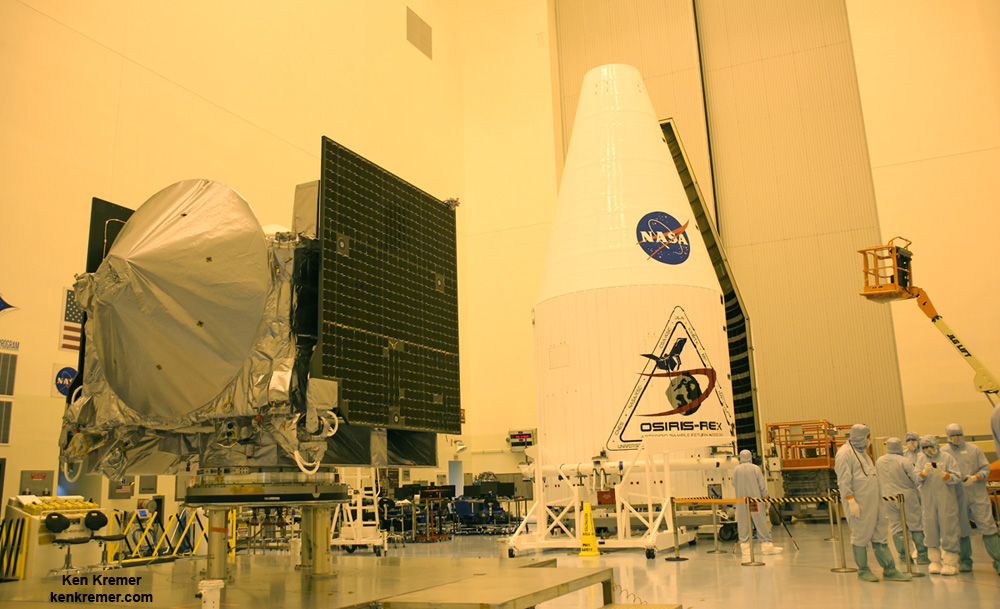
NASA's OSIRIS-REx asteroid sampling spacecraft, return capsule and payload fairings inside the Payloads Hazardous Servicing Facility high bay at NASA's Kennedy Space Center is being processed for Sep. 8, 2016 launch to asteroid Bennu from Cape Canaveral, FL. Credit: Ken Kremer/kenkremer.com
The allure of Bennu is that it is a carbon rich asteroid - thus OSIRIS-REx could potentially bring back samples infused with the organic chemicals like amino acids that are the building blocks of life as we know it.
"We are interested in that material because it is a time capsule from the earliest stages of solar system formation," OSIRIS-Rex Principal Investigator Dante Lauretta told Universe Today in a prelaunch interview with the spacecraft in the cleanroom at NASA's Kennedy Space Center.
The do or die gravity assist plunge is absolutely essential to set OSIRIS-REx on course to match the asteroid's path and speed when it reaches asteroid Bennu a year from now in Fall 2018.
"The Earth Gravity Assist is a clever way to move the spacecraft onto Bennu's orbital plane using Earth's own gravity instead of expending fuel," says Lauretta, of the University of Arizona, Tucson.
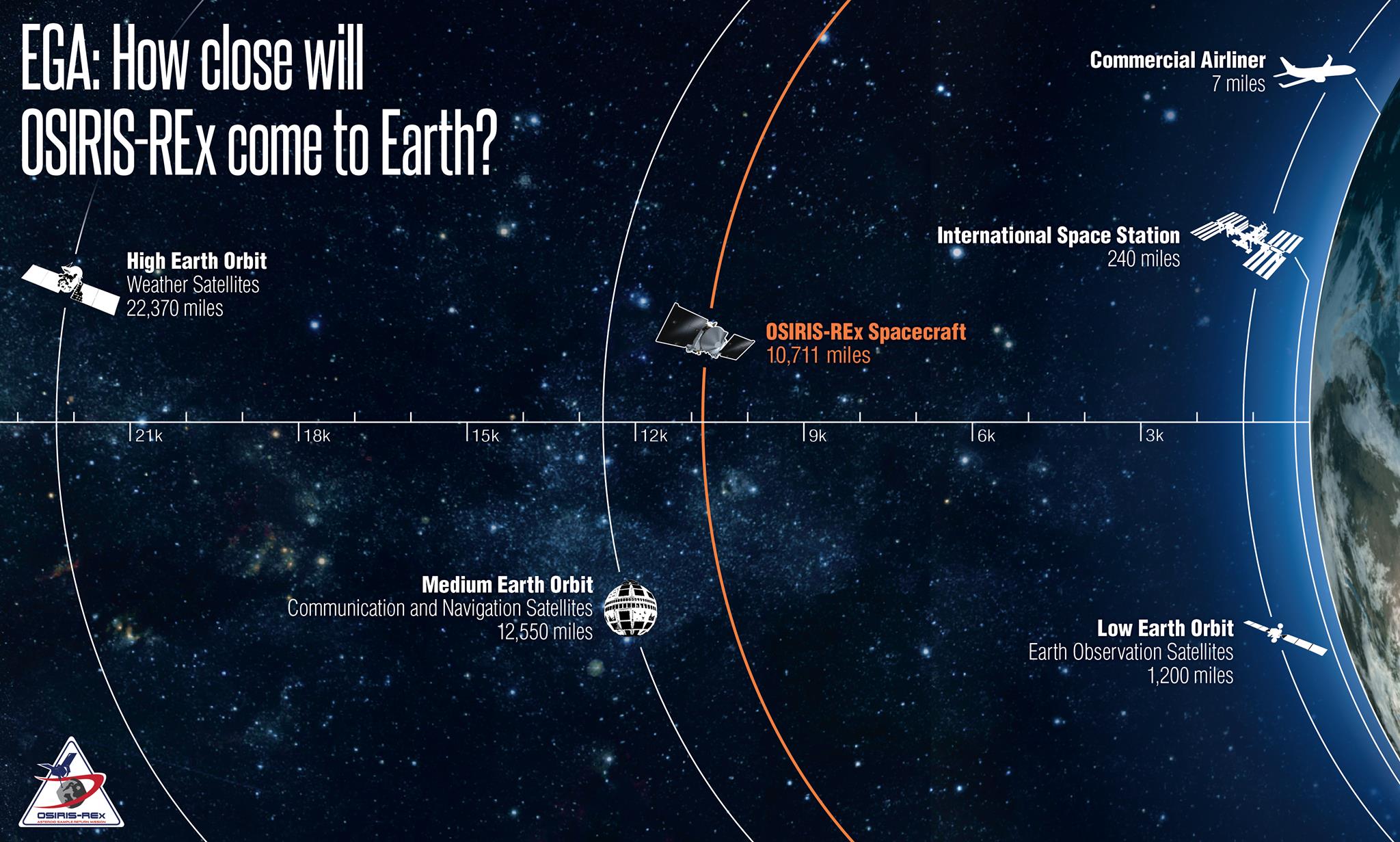
Just how close to Earth will OSIRIS-REx be during its flyby on Friday? The spacecraft will come within 11,000 miles (17,000 km) of the Earth's surface as it passes over Antarctica at 12:52 a.m. EDT. on Sept. 22, 2017. Credits: NASA's Goddard Space Flight Center/University of Arizona
Bennu's orbit around the Sun is tilted at a six-degree inclination with respect to Earth's orbital plane.
The asteroid is 1,614-foot (500 m) in diameter and crosses Earth's orbit around the sun every six years.
Numerous NASA spacecraft – including NASA's just completed Cassini mission to Saturn – utilize gravity assists around a variety of celestial bodies to gain speed and change course to save vast amounts of fuel and time in order to accomplish science missions and visit additional target objects that would otherwise be impossible.
The flyby will be a nail-biting time for NASA and the science team because right afterwards the refrigerator sized probe will be out of contact with engineers - unable to receive telemetry for about an hour.
"For about an hour, NASA will be out of contact with the spacecraft as it passes over Antarctica," said Mike Moreau, the flight dynamics system lead at Goddard, in a statement.
"OSIRIS-REx uses the Deep Space Network to communicate with Earth, and the spacecraft will be too low relative to the southern horizon to be in view with either the Deep Space tracking station at Canberra, Australia, or Goldstone, California."
NASA says the team will regain communication with OSIRIS-REx roughly 50 minutes after closest approach over Antarctica at about 1:40 p.m. EDT.
The post flyby science campaign is set to begin at 4:52 p.m. EDT, Friday, Sept. 22.
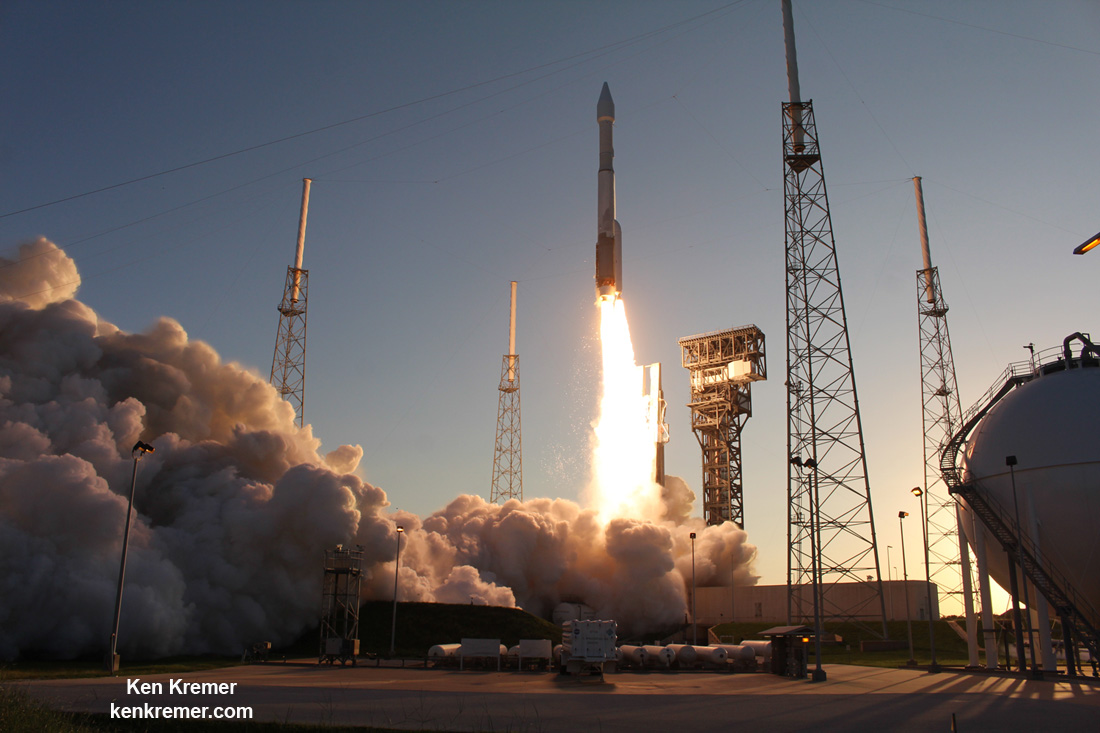
United Launch Alliance Atlas V rocket lifts off from Space Launch Complex 41 at Cape Canaveral Air Force Station carrying NASA's Origins, Spectral Interpretation, Resource Identification, Security-Regolith Explorer, or OSIRIS-REx spacecraft on the first U.S. mission to sample an asteroid, retrieve at least two ounces of surface material and return it to Earth for study. Liftoff was at 7:05 p.m. EDT on September 8, 2016 in this remote camera view taken from inside the launch pad perimeter. Note the newly install crew access arm and white room for astronaut flights atop Atlas starting in early 2018. Credit: Ken Kremer/kenkremer.com
The OSIRIS-Rex spacecraft originally departed Earth atop a United Launch Alliance Atlas V rocket under crystal clear skies on September 8 at 7:05 p.m. EDT from Space Launch Complex 41 at Cape Canaveral Air Force Station.
Everything with the launch went exactly according to plan for the daring mission boldly seeking to gather rocks and soil from carbon rich Bennu.
OSIRIS-Rex is equipped with an ingenious robotic arm named TAGSAM designed to collect at least a 60-gram (2.1-ounce) sample and bring it back to Earth in 2023 for study by scientists using the world's most advanced research instruments.
"The primary objective of the OSIRIS-Rex mission is to bring back pristine material from the surface of the carbonaceous asteroid Bennu," OSIRIS-Rex Principal Investigator Dante Lauretta told me in the prelaunch interview in the KSC cleanroom with the spacecraft as the probe was undergoing final launch preparations.
"We are interested in that material because it is a time capsule from the earliest stages of solar system formation."
"It records the very first material that formed from the earliest stages of solar system formation. And we are really interested in the evolution of carbon during that phase. Particularly the key prebiotic molecules like amino acids, nucleic acids, phosphates and sugars that build up. These are basically the biomolecules for all of life."
NASA and the mission team is also inviting the public to get engaged by participating in the Wave to OSIRIS-REx social media campaign.
"Individuals and groups from anywhere in the world are encouraged to take photos of themselves waving to OSIRIS-REx, share them using the hashtag #HelloOSIRISREx and tag the mission account in their posts on Twitter (@OSIRISREx) or Instagram (@OSIRIS_REx).
Participants may begin taking and sharing photos at any time—or wait until the OSIRIS-REx spacecraft makes its closest approach to Earth at 12:52p.m. EDT on Friday, Sept. 22."
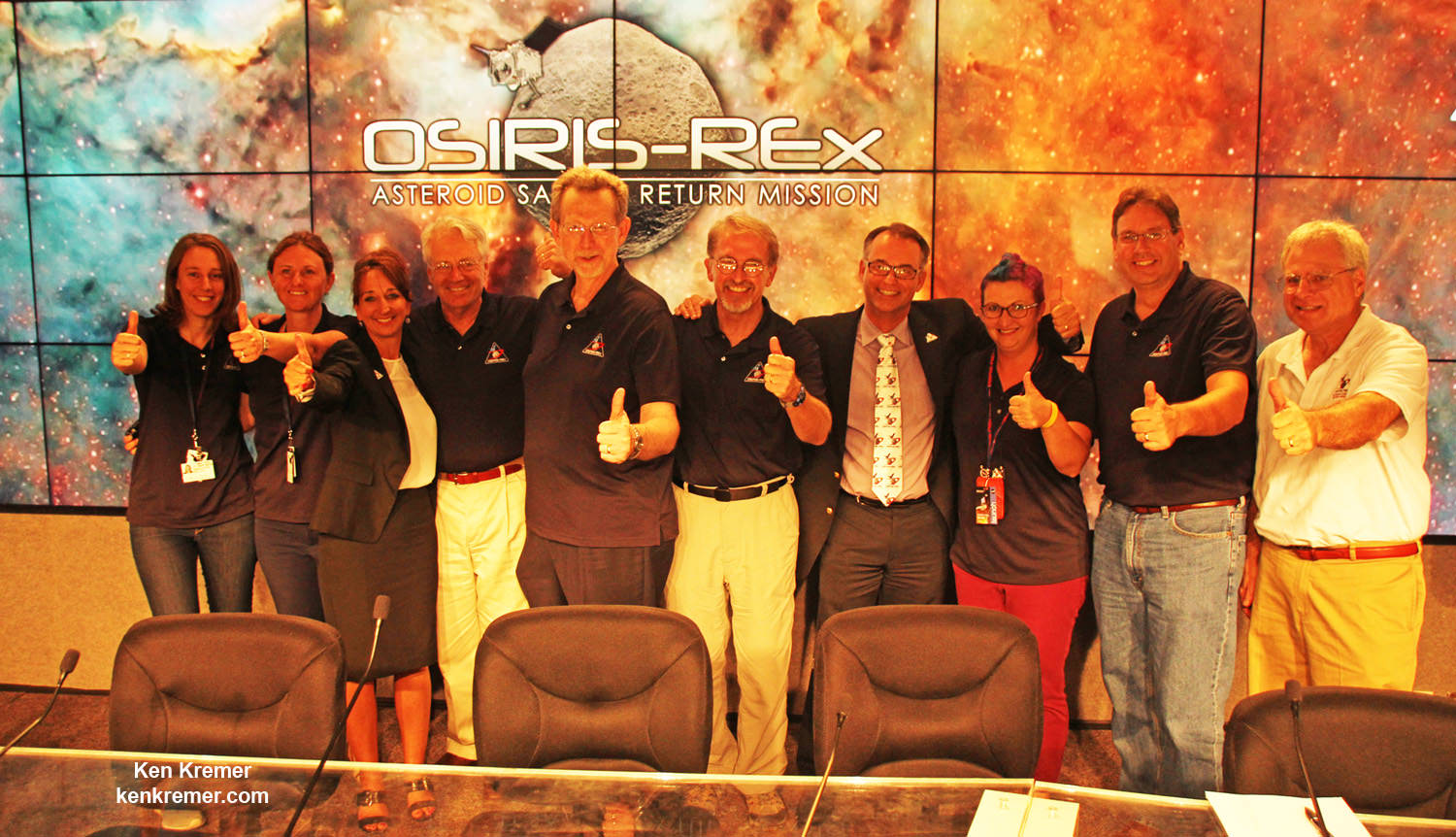
Members of the OSIRIS-REx mission team celebrate the successful spacecraft launch on Sept. 8, 2016 atop ULA Atlas V at the post-launch briefing at the Kennedy Space Center, FL. Principal Investigator Dante Lauretta is 4th from right, NASA Planetary Science Director Jim Green is center, 5th from left. Credit: Ken Kremer/kenkremer.com
Watch for Ken's continuing onsite NASA mission and launch reports direct from the Kennedy Space Center and Cape Canaveral Air Force Station, Florida.
Stay tuned here for Ken's continuing Earth and Planetary science and human spaceflight news.
Ken Kremer
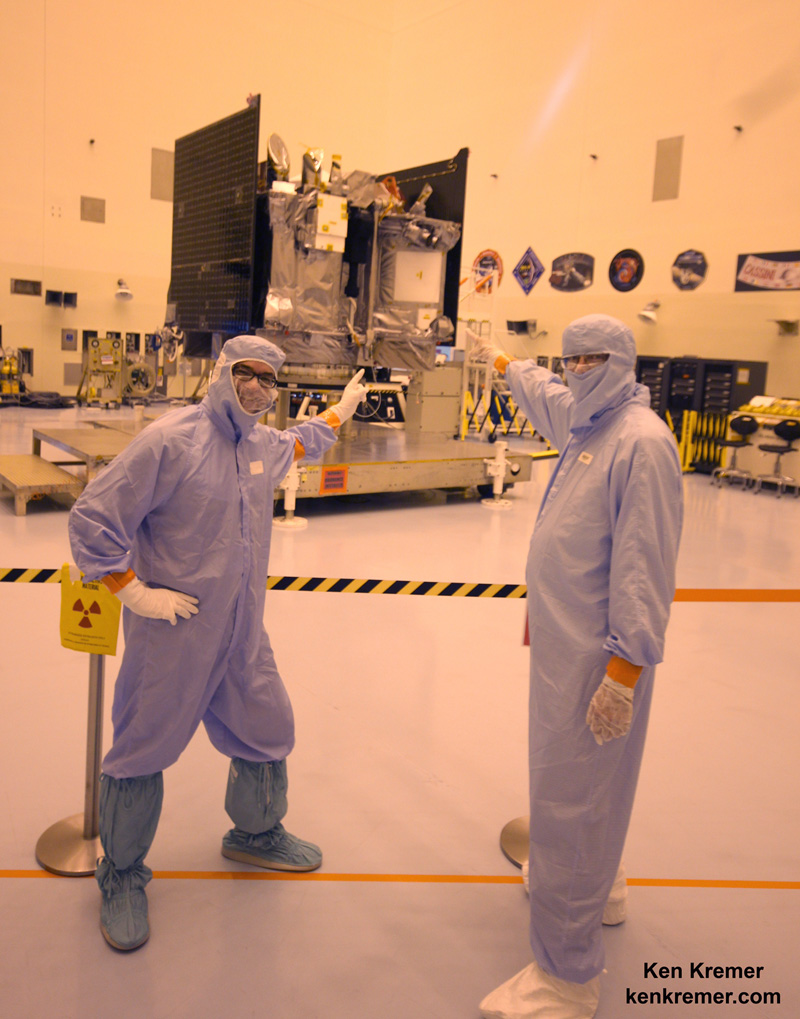
Dr Dante Lauretta, principal investigator for OSIRIS-REx at the University of Arizona, Tucson, and Dr. Ken Kremer, Universe Today point to NASA's OSIRIS-REx asteroid sampling spacecraft inside the Payloads Hazardous Servicing Facility at the Kennedy Space Center on Aug. 20, 2016. Credit: Ken Kremer/kenkremer.com
No comments:
Post a Comment